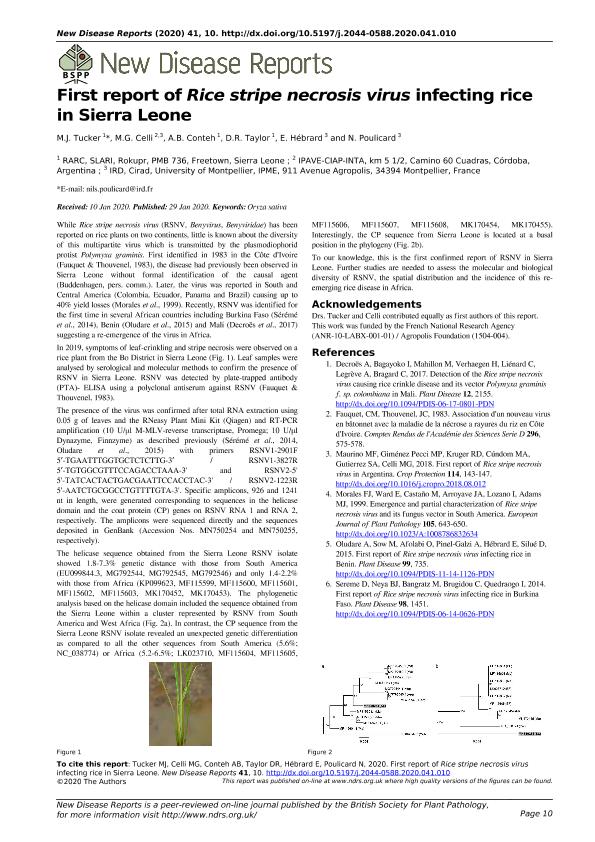Artículo
First report of Rice stripe necrosis virus infecting rice in Sierra Leone
Tucker, M. J.; Giovani Celli, Marcos Giovani ; Conteh, A. B.; Taylor, D. R.; Hebrard, Andrés; Poulicard, N.
; Conteh, A. B.; Taylor, D. R.; Hebrard, Andrés; Poulicard, N.
 ; Conteh, A. B.; Taylor, D. R.; Hebrard, Andrés; Poulicard, N.
; Conteh, A. B.; Taylor, D. R.; Hebrard, Andrés; Poulicard, N.
Fecha de publicación:
01/2020
Editorial:
John Wiley and Sons Inc
Revista:
New Disease Reports
ISSN:
2044-0588
Idioma:
Inglés
Tipo de recurso:
Artículo publicado
Clasificación temática:
Resumen
While Rice stripe necrosis virus (RSNV, Benyvirus, Benyviridae) has been reported on rice plants on two continents, little is known about the diversity of this multipartite virus which is transmitted by the plasmodiophorid protist Polymyxa graminis. First identified in 1983 in the Côte d´Ivoire (Fauquet & Thouvenel, 1983), the disease had previously been observed in Sierra Leone without formal identification of the causal agent (Buddenhagen, pers. comm.). Later, the virus was reported in South and Central America (Colombia, Ecuador, Panama and Brazil) causing up to 40% yield losses (Morales et al., 1999). Recently, RSNV was identified for the first time in several African countries including Burkina Faso (Sérémé et al., 2014), Benin (Oludare et al., 2015) and Mali (Decroës et al., 2017) suggesting a re-emergence of the virus in Africa.In 2019, symptoms of leaf-crinkling and stripe necrosis were observed on a rice plant from the Bo District in Sierra Leone (Fig. 1). Leaf samples were analysed by serological and molecular methods to confirm the presence of RSNV in Sierra Leone. RSNV was detected by plate-trapped antibody (PTA)- ELISA using a polyclonal antiserum against RSNV (Fauquet & Thouvenel, 1983).The presence of the virus was confirmed after total RNA extraction using 0.05 g of leaves and the RNeasy Plant Mini Kit (Qiagen) and RT-PCR amplification (10 U/μl M-MLV-reverse transcriptase, Promega; 10 U/μl Dynazyme, Finnzyme) as described previously (Sérémé et al., 2014, Oludare et al., 2015) with primers RSNV1-2901F 5′-TGAATTTGGTGCTCTCTTG-3′ / RSNV1-3827R 5′-TGTGGCGTTTCCAGACCTAAA-3´ and RSNV2-5´ 5´-TATCACTACTGACGAATTCCACCTAC-3´ / RSNV2-1223R 5´-AATCTGCGGCCTGTTTTGTA-3´. Specific amplicons, 926 and 1241 nt in length, were generated corresponding to sequences in the helicase domain and the coat protein (CP) genes on RSNV RNA 1 and RNA 2, respectively. The amplicons were sequenced directly and the sequences deposited in GenBank (Accession Nos. MN750254 and MN750255, respectively).The helicase sequence obtained from the Sierra Leone RSNV isolate showed 1.8-7.3% genetic distance with those from South America (EU099844.3, MG792544, MG792545, MG792546) and only 1.4-2.2% with those from Africa (KP099623, MF115599, MF115600, MF115601, MF115602, MF115603, MK170452, MK170453). The phylogenetic analysis based on the helicase domain included the sequence obtained from the Sierra Leone within a cluster represented by RSNV from South America and West Africa (Fig. 2a). In contrast, the CP sequence from the Sierra Leone RSNV isolate revealed an unexpected genetic differentiation as compared to all the other sequences from South America (5.6%; NC_038774) or Africa (5.2-6.5%; LK023710, MF115604, MF115605, MF115606, MF115607, MF115608, MK170454, MK170455). Interestingly, the CP sequence from Sierra Leone is located at a basal position in the phylogeny (Fig. 2b).To our knowledge, this is the first confirmed report of RSNV in Sierra Leone. Further studies are needed to assess the molecular and biological diversity of RSNV, the spatial distribution and the incidence of this re-emerging rice disease in Africa.
Palabras clave:
BENYVIRUS
,
ARROZ
,
RSNV
Archivos asociados
Licencia
Identificadores
Colecciones
Articulos (UFYMA)
Articulos de UNIDAD DE FITOPATOLOGIA Y MODELIZACION AGRICOLA
Articulos de UNIDAD DE FITOPATOLOGIA Y MODELIZACION AGRICOLA
Citación
Tucker, M. J.; Giovani Celli, Marcos Giovani; Conteh, A. B.; Taylor, D. R.; Hebrard, Andrés; et al.; First report of Rice stripe necrosis virus infecting rice in Sierra Leone; John Wiley and Sons Inc; New Disease Reports; 41; 1; 1-2020; 10-10
Compartir
Altmétricas



